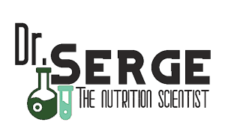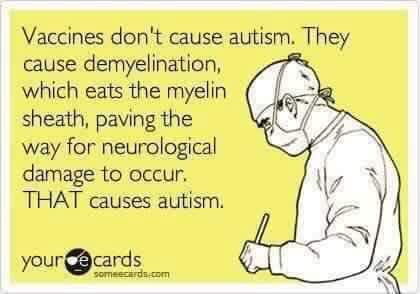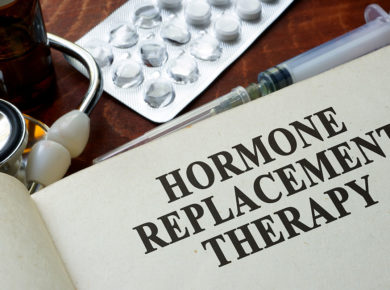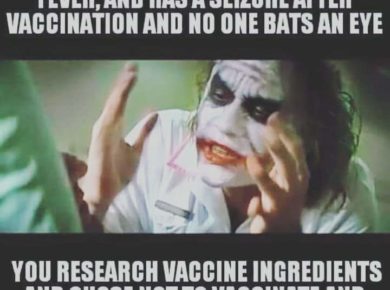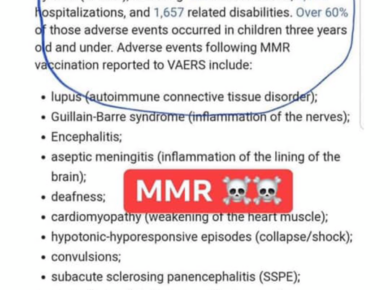In every case of autism, fungus (and mold) overgrowth is involved.
Let’s take a look at this study:
“Case Study: Rapid Complete Recovery From An Autism Spectrum Disorder After Treatment of Aspergillus With The Antifungal Drugs Itraconazole And Sporanox.”
The authors state:
“Escalation of the dose of itraconazole resulted in a complete loss of all symptoms of autism over the course of three months. This rapid, complete reversal of autism is consistent with several articles proposing mold in general and Aspergillus specifically as a potential major cause of autism.”
Here’s another study:
“Reduction in Obsessive Compulsive Disorder and Self-Injurious Behavior With Saccharomyces boulardii in a Child with Autism: A Case Report.”
“Alterations in microbial diversity influence neuroinflammation and are linked to mood disorders, abdominal pain, and SIB. S. boulardii is a nonpathogenic probiotic yeast that supports a healthy microbiome, enhances immune function, and reduces diarrhea. Treatment with S. boulardii successfully reduced OCD and SIB symptoms in this child.”
We know that yeast/parasite overgrowth leads to inflammation.
It is becoming increasingly clear that autism is an inflammatory process.
Genetics has very little to do with the progression of this disease. It is mainly an epigenetics disorder.
The paper is the first evidence of immune response targeting brain cells in autism.
2.5K
“T lymphocytes and cytotoxic astrocyte blebs correlate across autism brains” published in the Annals of Neurology.
Here’s the link:
https://onlinelibrary.wiley.com/doi/abs/10.1002/ana.25610
The authors conclude:
“The findings suggest dysregulated cellular immunity damages astrocytes at foci along the CSF–brain barrier in ASD.”
In other words, there is some sort of inflammatory response in the brain of autistic kids.
Autism spectrum disorders affect one in 59 American children by age eight.
With no known quantitative biological features, autism diagnoses are currently based on expert assessments of behavioral symptoms, including impaired social and communication skills, repetitive behaviors, and restricted interests.
As you can see, autism diagnostic can be very flexible based on the doctor looking at the situation.
This paper reports the presence of cellular features consistent with an immune response targeting specialized brain cells in more than two-thirds of autistic brains analyzed postmortem.
These cellular characteristics, which were not previously observed in autism, lend critical new insight into autism’s origins and could pave the way to improved diagnosis and treatment for people with this disorder.
Dr. Anderson, the lead researcher of this study, was examining brains donated to Autism BrainNet, a nonprofit tissue bank, when he noticed the presence of perivascular lymphocyte cuffs, an accumulation of immune cells surrounding blood vessels in the brain.
He also noted mysterious bubbles or blisters that scientists call blebs accumulating around these cuffed blood vessels.
His team subsequently found these blebs contained debris from a subset of brain cells called astrocytes.
Not previously linked to autism, perivascular lymphocyte cuffing is a well-known indicator of chronic inflammation in the brain. Lymphocyte cuffs in the brain are telltale signs of viral infections or autoimmune disorders.
This could lead to the hypothesis that a virus triggers autism.
Is there a connection with the MMR vaccines, like evidence suggests?
We know that kids can get encephalitis (brain inflammation) from the MMR shot.
On the other side, medical doctors claim that the MMR vaccine does not cause encephalitis, or they simply deny the connection despite tons of scientific evidence.
Let’s take a look at this question from a scientific perspective.
First, the insert of the vaccine claims that, among dozens of side effects, encephalitis does occur in kids after receiving the MMR shot.
So, Merck admits there is a direct link between the two.
Several other studies have been performed, and it was concluded that the MMR vaccine does cause encephalitis.
As of June 2019 (the last time I looked at the VAERS reporting system), there are 127 reported cases of MMR vaccine-injured people in the Vaccine Adverse Event Reporting System (VAERS) for a total of 8964 reported cases.
The VAERS is a system where doctors report side effects from vaccinations. In 6 months, about 9000 cases were reported, which is very concerning, especially when we have been told over and over than vaccinations do not have side effects.
Among these 127 cases, 15 develop encephalitis following the MMR vaccine.
It is known that 1 in 20,000 or 0.005% of measles cases result in measles encephalitis.
In the first half of 2019, there were 900 cases of measles that were reported in the country. Based on this statistic, a maximum of one kid at the most develop encephalitis. But we know that none of the children infected with the measles develop brain inflammation. All of them recovered well from the infection.
So, 900 cases of children got the measle with none of them who had encephalitis.
On the other side, 15 kids got brain inflammation following the MMR shot.
But it gets worse!
It is estimated that only 1% of the cases are being reported to the VAERS. If that is the case, up to 1500 children developed encephalitis following the MMR.
It gets scarier when you realize that encephalitis is a synonym for autism.
Dr. Wakefield and 34 other doctors clearly demonstrated a link between the measles, gut health, and brain function.
In other words, the connection between autism and a viral trigger is possible if you consider the side effect of the MMR and the impact of the measles virus on gut function.
A new study led by Tufts University School of Medicine in Boston, Massachusetts, has found that high numbers of inflammatory protein are found in the brains of children with an autism spectrum disorder.
You can read the study at PNAS entitled:
“IL-37 is increased in the brains of children with autism spectrum disorder and inhibits human microglia stimulated by neurotensin.”
This is the link:
https://www.pnas.org/content/116/43/21659
Results showed that the brains of the children with ASD had increased numbers of a protein called Interleukin-18 (IL-18).
This particularly occurred in the amygdala, the part of the brain that is responsible for detecting fear, and the dorsolateral prefrontal cortex, which is involved in cognitive skills that include working memory, attention, and evaluating rewards.
IL-18 is known to bring about serious inflammatory responses, which suggests it may play a role in some inflammatory diseases, particularly of the skin, such as psoriasis.
Researchers also found increased numbers – but not as many – of IL-37, which is an anti-inflammatory protein.
They believe that drugs that target IL-37 could be a therapeutic treatment and decrease the amount of IL-18 in the brain.
The authors said:
“ASD does not have distinct pathogenesis or effective treatment. Increasing evidence supports the presence of immune dysfunction and inflammation in the brains of children with ASD”.
This statement from these doctors makes me very nervous.
We can see that the medical community is so wrong with it comes to autism and what might be causing it.
They are very obsessed with genetic factors causing ASD. They have spent millions of dollars on hunting a gene or genes that cause autism—what a waste of money and time.
But we know that genetics has nothing to do with autism and related disorders.
Like the authors of the article below said, they want to find something to reduce the level of pro-inflammatory molecules like IL-18 and IL-37. They are looking for a new drug to achieve this.
But these are surrogate markers of inflammation.
Having a drug that reduces these markers is a band-aid.
When you see the light on your car dashboard, you go to the mechanics to figure out why right?
You simply just do not cut it off to turn off the light and believing your problem is gone.
Unfortunately, the medical community uses this approach. They will never find a cure because they do not ask the right questions.
We know that autism is an environmental disorder.
Yes, genes can make one more susceptible to develop autism, but at the end of the day, the actual cause is environmental factors.
About 1 percent of the world population has autism spectrum disorder.
Prevalence in the United States is estimated at 1 in 59 births.
More than 3.5 million Americans live with an autism spectrum disorder.
The prevalence of autism in U.S. children increased by 119.4 percent from 2000 (1 in 150) to 2010 (1 in 68). Autism is the fastest-growing developmental disability.
Prevalence has increased by 6-15 percent each year from 2002 to 2010.
Autism services cost U.S. citizens $236-262 billion annually.
A majority of costs in the U.S. are in adult services – $175-196 billion, compared to $61-66 billion for children.
The cost of lifelong care can be reduced by 2/3 with early diagnosis and intervention. (Autism. 2007 Sep;11(5):453-63; The economic consequences of autistic spectrum disorder among children in a Swedish municipality. Järbrink K1.)
One percent of the adult population of the United Kingdom has autism spectrum disorder.
The U.S. cost of autism over the lifespan is about $2.4 million for a person with an intellectual disability or $1.4 million for a person without an intellectual disability.
35 percent of young adults (ages 19-23) with autism have not had a job or received postgraduate education after leaving high school.
It costs more than $8,600 extra per year to educate a student with autism. (Lavelle et al., 2014) (The average cost of educating a student is about $12,000 – NCES, 2014)
What about if those $1.8 billion were used to actually help those kids?
We know that autism is an inflammatory disorder.
And we know that the main driver of this condition is environmental toxins.
We hear a lot about vaccines, but there are other sources of toxins like pesticides, mercury, aluminum, fluoride, cadmium, thallium, etc.
Literally, hundreds of toxins are potentially involved in the onset of ASD.
Then, we need to look at nutritional deficiencies and diet.
Again, why don’t we use those dollars to detox those kids, give them good nutrition, restore their lives instead of putting a band-aid on their problems?
This would happen only if the officials have the courage to face their failures and admit they were wrong.
God bless y’all 😊
Dr. Serge
